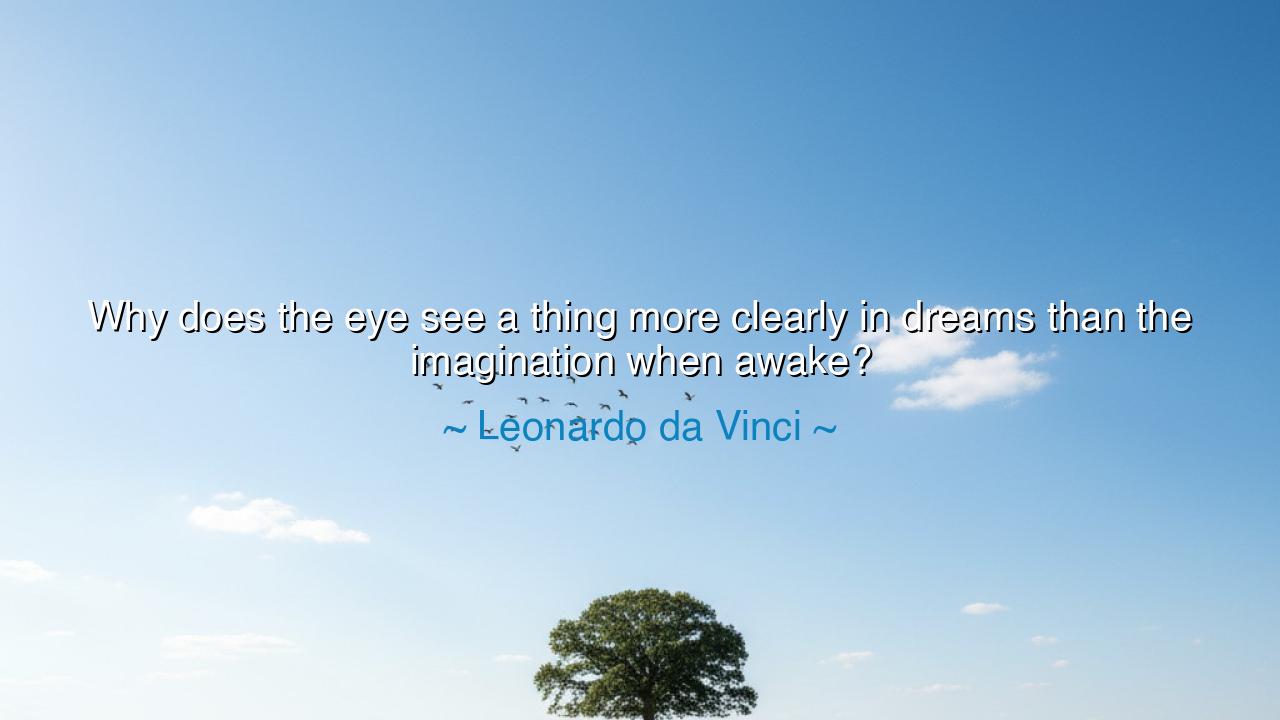
Why does the eye see a thing more clearly in dreams than the






“Why does the eye see a thing more clearly in dreams than the imagination when awake?” Thus spoke Leonardo da Vinci, the master of vision and mystery, whose mind moved between the realms of art and science, of heaven and earth. His question, like so many of his thoughts, pierces beyond the veil of the obvious and invites us into the hidden workings of the soul. In this reflection, Leonardo wonders at the strange power of the dream, where the eye of the mind sees with greater clarity than the waking intellect. He does not speak here of ordinary sight, but of inner perception, of the mysterious vision that reveals itself when the noise of the waking world is silenced.
To understand this quote, one must first know Leonardo’s nature. He was a man who sought truth not only in the laboratory of the world but in the landscape of the spirit. He studied light, shadow, and form, yet he also knew that the imagination — that sacred power of the mind — was the true painter of reality. But in this saying, he confesses a wonder: that in dreams, we often see with a purity and sharpness denied to us when awake. Why is it so? Because in dreams, reason loosens its grip, and the soul is free to see without the interference of doubt. The barriers of logic fall away, and imagination, released from the confines of fear and habit, becomes divine sight.
In waking life, the imagination is chained by caution, by judgment, by the demands of the world. We ask whether something is possible, whether it makes sense, whether it will be approved by others. But in the dream, there are no such limits. There, the eye of the heart opens wide, seeing truth not as the mind defines it, but as the spirit feels it. Leonardo understood that our greatest visions — the works of art, the discoveries of science, the movements of the soul — begin as dreams. The dream is not illusion; it is pure imagination unbound, and it often reveals realities our waking reason cannot yet accept.
Think of Isaac Newton, who sat beneath the apple tree not as a man of reason only, but as a dreamer who saw what others could not — that the falling fruit and the orbiting moon obeyed the same invisible law. Or consider Mary Shelley, who dreamt of a scientist who created life, and thus gave birth to Frankenstein, a work that would forever alter the imagination of mankind. In each of these, the dream revealed a vision clearer than the waking eye, for it was born of the deeper sight that Leonardo spoke of — the sight of the inner world, where the boundaries of reality dissolve and truth takes shape.
But Leonardo’s words also conceal a warning. Though dreams may grant us clearer visions, they are fleeting. The challenge of life is not merely to dream, but to bring the dream into waking form. The artist, the thinker, the builder — all must strive to give substance to what the soul has seen. Leonardo himself was a master of this translation: he saw in his dreams the flight of birds, the flowing of rivers, the grace of the human form, and sought to capture them with brush and invention. He knew that the dream is only the seed; the waking imagination, disciplined and patient, must bring forth its fruit.
The meaning of Leonardo’s question, then, is twofold: it is both wonder and challenge. He marvels that in the silence of dreams, we see truth unclouded — but he also calls upon us to remember that such sight is possible even while awake, if only we quiet the noise of fear and reason. The mind that dreams while awake — that is, the mind that sees with imagination undimmed — can reshape the world. To do so is to live as Leonardo lived: half in the world of form, half in the realm of vision.
So, dear seeker, take this teaching to heart. Do not despise your dreams, for they are messages from the deeper self, whispers of what your waking life might yet become. But do not remain in dreaming; awaken with purpose. Let your imagination be as the eye of your spirit, and let your waking deeds give flesh to what that eye has seen. For when the boundaries between dreaming and waking dissolve, you will live as the great masters did — seeing clearly not only in sleep, but in life itself. Then, as Leonardo taught through both his art and his wonder, your vision will no longer be bound by what is, but illuminated by what could be — and you will see the world not merely with your eyes, but with your soul.






AAdministratorAdministrator
Welcome, honored guests. Please leave a comment, we will respond soon